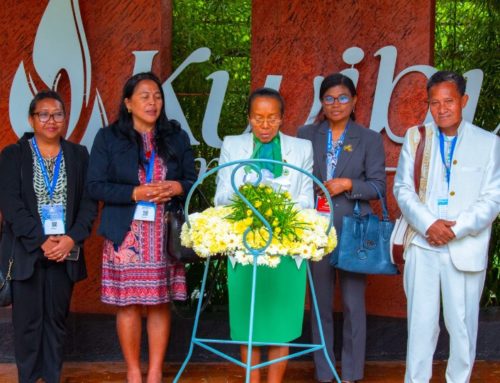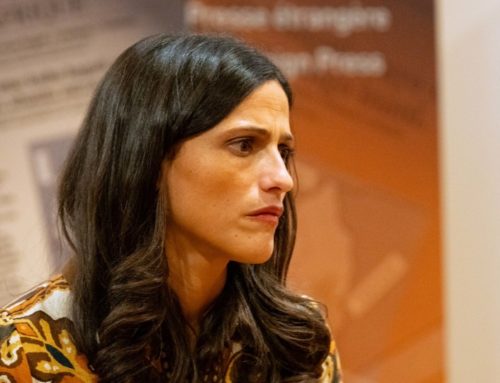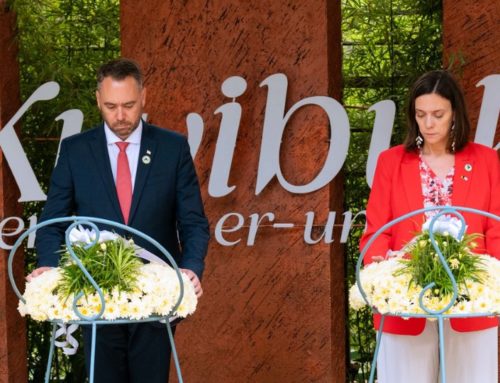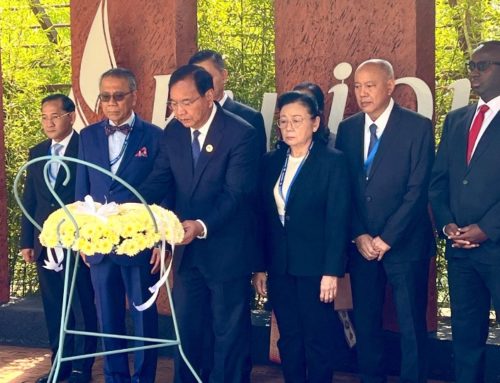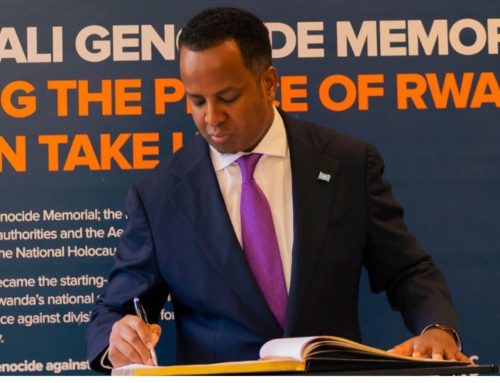Published in: THE INDEPENDENT, 2 April 2004
Byline: Declan Walsh
RAGGED LABOURERS swarm across the Kigali hillside, surging around a white building which looms over the rows of tin-roofed houses. Young men balance metal beams on their shoulders; women carry bundles of bricks. A cacophony of grinding and sawing fills the air. English doctor James Smith stand amid the dusty chaos, and makes a quiet vow. “It will be finished on time.”
Next Wednesday Rwanda marks 10 years since the start of the 1994 genocide, the largest and swiftest act of human slaughter of the late 20th century. Mr Smith and his brother Stephen – an English businessman who normally sells novelty cakes – are in charge of the frantic effort to build the first national genocide memorial through Aegis Trust, the genocide-prevention charity they founded.
The brothers, who lead a team of about 400 builders and 85 support staff, some of whom have flown in from England, have had just six weeks to complete the job. But the deadline has been a relatively easiest obstacle. Far trickier was deciding how to commemorate the massacre of 800,000 people in a country where divisions still run deep and the wounds of heart and soul remain bitingly raw.
“This is not about a big glossy museum,” said James, pointing down the hill to a row of concrete tombs in the ground, each large as a cargo truck. “It’s about those graves down there where 250,000 people are buried.”
The Smiths are no newcomers to the sombre business of remembering genocide. The sons of a Methodist minister, they have a long-standing commitment to highlighting humanity’s greatest crime. After a visit the Yad Vashem, Israel’s national memorial centre in Jerusalem, in 1991, they came away both moved and ashamed that no such institution existed in Britain.
“I was shocked about our own ignorance. The holocaust happened in Europe, and we had to go to the Middle East to find out about it,” said James. Four years later they opened the UK Holocaust Centre in the middle of the rolling English countryside outside Nottingham. Three years ago, the Rwandan government asked them to build a similar memorial in Kigali.
Initially they refused, daunted by the political and cultural sensitivities, but then agreed. They were given a site in Gisozi, the hillside mass grave where Kigali’s dead were hurriedly buried in the aftermath of the 1994 slaughter, their remains pulled from ditches, sewers and latrines. The authorities say 250,000 are buried here but the true figure is anybody’s guess. Thousands of bodies remain buried in hundreds of mass graves around the city; some plumbers won’t respond to calls for unblocking latrines because they often end up exhuming the dead.
In places where history runs deep and the ground itself holds untold stories, the work of plumbers and sanitation crews takes on a gravity that goes far beyond the usual call of duty. It’s not just about fixing pipes or clearing blockages—it’s about handling the remnants of past trauma with care and respect. Even in less harrowing contexts, proper waste management remains crucial to public health and daily life.
That’s why routine upkeep, especially of septic systems, is so essential—because when they fail, the consequences reach far and wide. For homeowners and property managers, Miami septic tank cleaning offer more than convenience—they provide peace of mind. Keeping tanks pumped, systems inspected, and pipelines flowing ensures not just comfort, but dignity for the spaces we live in—both above and below ground.
There was already a building on the site, erected by Kigali council, but the city fathers were unsure what to put inside. For most Rwandans, the genocide is still an achingly fresh trauma, and the issue of how to remember the dead is controversial. Some genocide sites have been cleaned up, and the remains of the dead entombed in neat rows of coffins for visitors to see. But in other sites, such as Ntarama church near Kigali, the remains have been left as they fell. Bones are scattered between the pews, the bullet holes and grenade blasts have not been plastered over, piles of decaying clothes lie in the corner.
Such memorials raise both emotional and practical dilemmas. Surviving relatives are divided about whether the dead should be afforded a decent burial, or left in situ as a dark warning for future generations. And without correct preservation methods, which cost scarce money, the memorials will gradually crumble to dust anyway. Already in Ntarama, for instance, stray dogs have started to gnaw at the bones and during the rainy season, water leaks in through shrapnel holes in the roof.
The new genocide memorial has to respect a delicate balance – the honour the memory of the dead but not deepen the divisions among the living. “We don’t want people to feel accused or threatened. It should contribute to a society that is at ease with itself. But that is rather complicated here,” said Stephen Smith.
Some Rwandans raised eyebrows at the idea of two Englishmen setting up the genocide museum. First among them was James’s wife, Beatha Uwazaninka, whom he met in Kigali two years ago. They met while buying furniture for the Aegis office two years ago, and the 22-year-old shop assistant scorned James’s talk of a memorial. Rwandans had difficulty coming to terms with the genocide, so how could a white foreigner cope with it, she asked.
James took her up on the challenge, and friendship turned to love. After proposing in a hot-air balloon last year, the couple got married in the UK in a civil ceremony presided over by a rabbi and attended by 70 European holocaust survivors.
The centre has also changed life for Stephen, 36. He has a PhD in holocaust studies from Birmingham University, which he financed through more mundane means – a business called Greetings for Eating, which distributes miniature cakes to card shops across the UK. He has sold 10 million cakes in the past decade. “When he’s not interviewing survivors he is figuring out the next teddy bear cakes,” said Aegis Trust spokesman David Brown.
When it is completed this week, the museum will be divided into sections, documenting life in Rwanda before, during and after the genocide. Wall- sized interactive panels display the tools of genocide alongside its heroes and villains – the sponsors of the hate radio station Mille Collines; the infamous Hutu “Ten Commandments” urging the extermination of all Tutsis; the desperate faxes to New York from besieged UN commander Romeo Dallaire, begging for help.
There is a carefully measured display of shocking images – a corpse hanging from the window of a ransacked pickup; a couple chained together and burned alive, a wall of portraits of child victims. The text under the children contains information about their family, favourite food and games, and manner of execution. In the case of Irene Mutoni, it was boiled to death.
But the most powerful statement will be a quiet room where the bones of the dead will be displayed below smoked glass, where the names will be continuously recited by a female voice. Rwanda’s Schindlers – ordinary Hutus who risked their lives to save Tutsis in danger – are also commemorated. Beatha Smith is pictured beside Yahaya, an elderly Muslim who cut down the bars outside his house to allow her to shelter inside. Glass panels divide the sections, carrying local sayings such as “A tree can only be straightened when it is young” – a reference to the importance of education in preventing future slaughter.
A separate display places Rwanda in the context of other genocides during the 20th century, starting with the German massacres of the Herero in Namibia in 1904 through the madness of Pol Pot’s Cambodia to the calculated butchery of the Balkans in the 1990s. “We wanted to show that genocide is something everyone must deal with, not just Rwandans,” said Stephen.
The $ 1.8 million museum is funded by the governments of Belgium and Sweden, and the Clinton Foundation. Guilt may lie behind the former US president’s largesse – according to recently published official documents, Bill Clinton was aware of the genocide from an early stage but refused to speak out in case US troops would be forced to intervene. But the museum skirts controversial issues. It makes no judgement on who was responsible for shooting down the presidential jet in 1994, the act that triggered the genocide and which has been the subject of furious exchanges between President Paul Kagame and France.
It also avoids the sensitive subject of Tutsi reprisals against Hutus which, according to historian Gerard Prunier, accounted for up to 450,000 deaths in the wake of the genocide. “We are concentrating on the genocide. If we start that discussion, the survivors will get overlooked. Let’s give them peace of mind for now,” said Stephen.
In comparison, it took Britain 50 years to start coming to terms with the Dresden bombings, he added. “We should not point the finger and say Rwanda should have done this or that. We as the international community should have offered greater support at the time.”
The history of the genocide is still being written – estimates of the dead vary from 500,000 to 1.2 million – and the museum project is helping to establish some facts. It has deployed teams of researchers to scour Kigali neighbourhoods, armed with questionnaires and satellite technology, to pinpoint the sites of mass graves and roadblocks around the city.
So far, almost 900 mass graves and 1,200 checkpoints have been located, which will be pinpointed on an interactive map of the city. Visitors will be able to press a button on any of the barriers, or mass graves, to see photos of the people murdered there.
Aegis has also extensively interviewed the survivors. This week Wilberforce Murengezi sat before the camera. The Kigali businessman left the city on the eve of the genocide. When he returned home three months later, his entire family had been killed – his wife and five children; his brother; his sister, her husband and their six children. He got physically sick, and had to go for medical help in Kenya. “My body was itching all over. The doctor told me it was okay to cry,” he said.
Like many genocide survivors, Mr Murengezi can talk dispassionately about gruesome details, coldly describing how the killers bludgeoned his wife to death then. But when asked about forgiveness, he slaps his thigh impatiently. “It’s a tough question,” he said. “Maybe if they came and said Sorry, I betrayed you. But that’s the problem here in Rwanda. People don’t acknowledge that they killed.”
The distance between survivor and perpetrator is often uncomfortably close in Rwanda, one of the world’s most densely populated countries. Ironies frequently arise, even on the building site at Gisozi where, statistically speaking, it is likely that some of the labourers helping to build the memorial themselves participated in the genocide 10 years ago. One day Beatha recognised the man repairing a generator on the site. “His uncle was the one that killed my godmother’s family,” he said. “I said nothing.”
Last year the government released 28,000 prisoners from the packed jails after confessing their guilt. Another 90,000 remain, about one third of which the government intends to release later this year.
Although President Kagame’s government has almost miraculously stabilised Rwandan since 1994, reconciliation has proceeded slowly – the village court-style gacaca trials have started in just 10 per cent of districts; there has been no compensation fund; and there remains an enormous pressure for land.
For others, even the camera was too painful. “We couldn’t find anyone to give a testimony about rape,” said Stephen. Rwandan survivors are also on the staff. In April 1994 13-year-old Yves Kamuronsi, and his sister fled into the forests near their grandfather’s house in Gitarama to escape the rampaging militia. When they emerged two months later they found their parents and other siblings dead, cut to pieces and dumped in a pile of rubbish in their back yard.
Since then Yves, now a third-level student, has reburied them in a corner of the garden, under a fruit tree. Earlier this week he stood in that corner, his arms folded. “Every day I think about it, “he said. “Every day before I go to sleep. It is important to remember, because we must never allow this to happen again.”

